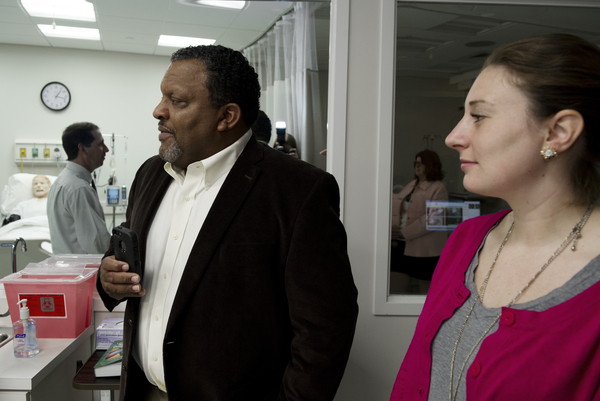Students get hands-on training in simulation lab

The Arnold S. Goldstein Simulation Laboratories Suite in the Bouvé College of Health Sciences has been up and running now for seven months—and already students such as senior Mary Williams, BHS’14, are feeling the impact of the cutting-edge training lab.
The lab suite features video-capture technology, four simulation bays, two debriefing rooms, and nine patient simulators. Together, they’re designed to facilitate healthcare instruction by utilizing computer-driven mannequins and lifelike models with which students and faculty can replicate clinical symptoms and modulate realistic human responses.
Williams is among a group of nursing students that used the lab for its senior capstone project on developing an effective communication strategy in an interdisciplinary hospital setting. The capstone involved creating videos that compared the correct and incorrect ways for an interdisciplinary team to communicate in three hypothetical hospital scenarios. Their work, she said, could serve as a learning tool for healthcare professionals and students.
On Monday, April 7, Williams observed from the Goldstein Simulation Laboratories Suite’s control room as other undergraduate nursing students went through trainings in the lab. The exercise involved diagnosing and treating patients suffering from acute pancreatitis. The students had to listen and react as the “patient”—a mannequin voiced by another student located in the control room—bellowed in agony as she described her mock symptoms. This hands-on training, Williams said, can provide invaluable experience, particularly before students embark on experiential learning opportunities at hospitals or health clinics.
“I could see how you could walk right into a co-op and be prepared,” she said. “This lab has already had a huge impact on me.”
Williams watched the exercises with a group of Bouvé faculty and staff and Gordon Thompson, DMSB’80, MBA’84, the chief executive officer for Westnet, Inc., a distributor of medical supplies and equipment, life science products, and industrial paper. Thompson’s company had just donated a large amount of much-needed supplies for use in the simulation suite—among them gloves, bandage rolls, and syringes.
As he toured the space on Monday, Thompson’s fascination and curiosity was palpable. “This is very impressive,” said Thompson, who asked a variety of questions including what other supplies the suite still needs and whether the students’ training sessions include behavioral interventions with patients. Earlier in the day, Thompson met with Terry Fulmer, dean of the Bouvé College of Health Sciences. “I hope it will give you great satisfaction to see your gift in action here in Bouvé and the simulation laboratories,” she told Thompson. “We are thrilled by this partnership and hope that this is the beginning of a continued collaboration.“
Northeastern officially unveiled the Goldstein Simulation Laboratories Suite, located in Behrakis Center, in September 2013. Marlene Goldstein invested $2 million to name the new simulation laboratories suite in memory of her late husband, Arnold S. Goldstein, P’61, PhD’90. Arnold Goldstein, who passed away in 2010, was a professor of pharmacy at Northeastern and had served as acting dean in what was then the College of Pharmacy and Allied Health Professions.
The suite is designed to enable a collaborative learning environment for students across health professions—from nurses and physician assistants to physical therapists, speech language pathologists, and pharmacists. By training students in techniques designed to ensure patient safety, improve outcomes, and prevent medical errors, the simulation suite will have a significant impact on the next generation of healthcare providers and bolster national efforts in health education, research, and service.
To learn more about the Arnold S. Goldstein Simulation Suite, please contact director Jamie Musler at j.musler@neu.edu





